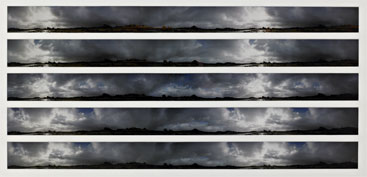
Born in 1943 in Montluçon (FR)
Lives and works in Paris (FR)

1986
Colour photographs, cibachromes
82,5 x 107,5 cm
Year of Purchase: 1990
Joachim Bonnemaison’s interest in photography is part and parcel of his work within a city planning research bureau. He accordingly undertakes scientific research projects to improve the angle of shots of wide angle cameras, which he manages to push to 560° and is also developing a specific camera. In his view, this discovery has made the perilous exercise of landscape photography possible – an exercise which is now his main activity.
‘Space is recorded gradually on a cylinder and no longer on a flat surface.’1 So photography no longer freezes just a space, but a moment as well. The panoramic shot, by its form, extension and capacity to assemble different viewpoints in a continuous image, calls to mind the practice of the fresco. To it however Bonnemaison adds a notion of time by presenting his images in triptych form: three copies of one and the same photograph taken at different moments, with changing light and sunshine. In this way, he records the passing of a day and prints its changes on film.
His work is nothing less than an analysis of landscape, a scientific composition of lines and curves, achieving harmony through contrasts and complementarity of forms. In Kerpont enes, ciel d’argent 1 the upside down and right side up sides are mixed, upsetting the viewer’s perception. This composition calls to mind the procedure of curved perspective, but pushed to its limit: the image wraps itself around a point, the sun, the technique used by Bonnemaison allows a wider gaze over the landscape and helps to grasp the freedom offered by natural space, turning these photographs, which are rich in features and colours, but with no trace of urbanism, into a real tribute to nature.
Anne Langlois
1 J. Bonnemaison in ‘Constructing the Landscapes of Photography’, Metz for Photography, 1984.